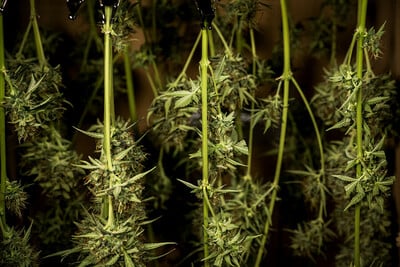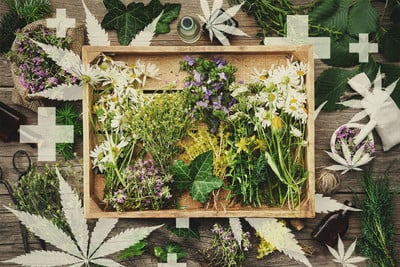.

How to Build an Automated Cannabis Curing System
An automated curing system can streamline the cannabis curing process and optimise the quality of your bud. Plus, it's a fun project for those who enjoy such tasks! Here we outline the benefits and caveats of crafting an auto-curing system, as well as directions for building your own.
Welcome to the future of cannabis cultivation, where automated cannabis curing systems take away all of your troubles. Well, not quite, but it can make life easier for those willing to put in the effort. In an era where efficiency and consistency are key in all walks of life, automation fulfills these needs and, also, just makes our lives a little easier (once we have the system set up).
These systems don’t just save precious time but also ensure each bud reaches its highest potential, achieving uniform dryness and optimal flavour. This means that after the painstaking months of careful growing, we can get everything just right at this final, important step. Indeed, curing is the last step in a long process, and it’s the one that really perfects our efforts. Whether you're managing large harvests or simply passionate about precision, understanding automated curing can make your life easier and your bud even better!
This article will guide you through everything from the basics of automated curing systems to building your very own DIY system.
What Is an Automated Cannabis Curing System?
An automated cannabis curing system is a solution that aims to make curing weed easier and more efficient. By automating the control of environmental factors such as relative humidity (RH) and air exchange (exactly the reason we “burp” curing jars), these systems ensure that cannabis buds cure evenly and efficiently. Ultimately, this process reduces the harsh flavours of chlorophyll and brings out the more delicate flavours of the many terpenes in your chosen bud.
Among growers for whom flavour is of the utmost importance, an automated curing system can take some of the randomness and chance out of the process, making high-quality, uniform results more likely. And for those who have a huge crop to cure, it can make the process much easier and more relaxed than it would otherwise be. Imagine having to open 100 small jars for five minutes every day to let your buds breathe—the work would quickly become overwhelming!
Key benefits of automated curing include:
- Consistency and quality: Automation reduces human error, ensuring every bud cures under optimal conditions.
- Efficiency: For cultivators dealing with large harvests, these systems significantly cut down the manual labour involved in curing.
- Optimal humidity control: Humidity packs and automated air exchange (burping) adjust the environment to maintain the perfect curing conditions, reducing the risk of both mould and over-drying.
- Scalability: Whether you're a hobbyist or a commercial grower, automated systems can be scaled to fit your needs.
- Increased freedom: You can leave the house for a day or two without worrying about your entire harvest coming to ruin in the time you’re away.
With systems ranging from auto-curing jars to sophisticated curing buckets and automatic burping jars, there's an automated solution to fit every grower's needs. In this article, we’ll focus on curing buckets, as they are easy to make and can range from small to very large, suiting practically all growers regardless of the size of their harvest.
What Is the Average Cure Time for Cannabis?
Typically, the cure time for cannabis can range from two weeks to over a month, depending on the strain, desired outcomes, and curing conditions. A shorter period tends to result in less-refined bud. This is suitable for hobbyist growers who don’t want to spend months waiting for their harvest to be ready to consume. However, if you can hold off a few more weeks, you can really get the most out of your bud.
Automated curing systems optimise the process by maintaining ideal RH and facilitating regular air exchange. This not only ensures a consistent and efficient cure but can also shorten the overall cure time by creating the perfect conditions from the start—a win-win situation! Properly cured cannabis results in a smoother, more enjoyable experience, with enhanced flavour profiles and potency.
How to Build an Automated Cannabis Curing System
If this sounds appealing to you, we’re here to show you how to build one of these systems for yourself at home. Doing so requires a bit of time, care, and equipment, and as such is best suited to those who actually enjoy such projects. If you get no satisfaction from DIY projects, then you’ll probably find your energy is better spent burping your jars by hand.
However, if you’re up for the challenge and love the feeling of building something that streamlines your life and gives your brain a workout, then keep reading.
Note: The bucket sizes provided below should cover most growers, but if you feel you would benefit from using a bigger or smaller bucket, then feel free to modify the size. The rest of the method will work for a range of sizes.
Equipment
- 10–20-litre bucket: BPA-free is best, and ensure it has a lid with an airtight seal
- Motorised air pump and digital timer: For air circulation and control
- Check valves: To prevent backflow
- Silicone tubing (3mm): For connecting components
- Manifold: To distribute air from the pump
- PVC tubing (16mm): For the main air conduit
- Stainless-steel hose clamp (13mm to 32mm): To secure connections
- Humidity control packs: For maintaining optimal humidity
- Safety pin: For creating air holes in the tubing
- Drill with 2.8mm drill bit
Directions
The following directions outline how to make your DIY curing system.
Step 1: Prepare the Bucket
- Drill two holes in each bucket; one near the top and one near the base. The holes are 2.8mm so that they create a seal around the 3mm tubing when it is inserted.
Step 2: Set Up Hoses
- Insert the intake hose (to be connected to the manifold) into the lower drilled hole.
- Cut a 15cm length of the 3mm tubing as the exhaust hose and insert it into the upper hole.
Step 3: Instal Check Valves
- Attach check valves to the ends of the hoses inside the bucket, ensuring proper airflow direction. For the bottom hose, attach the bigger side of the valve to the hose. For the top hose, attach the smaller side.
Step 4: Air Distribution Tubing
- Cut a 1m length of the 3mm tubing and evenly puncture it every 2.5 to 4cm with a safety pin or something similar.
- Connect this perforated tubing to the check valve at the bottom of the bucket, securing it with a tight knot.
- Arrange the tubing around the bucket's base, in a circle, for even air distribution.
Step 5: Connect the System
- Link the intake hose to the manifold and open the valve.
- Connect the manifold to the air pump, securing all connections with the hose clamp.
- Conduct a test run to check for airtightness and proper valve function. Listen for a hissing sound from the exhaust hose, indicating correct pressurisation.
Step 6: Filling and Operation
- Fill the bucket halfway with cannabis, then place in a humidity control pack (58–62% RH).
- Add more cannabis until the bucket is full, and top it with another humidity control pack.
- Secure the lid, start the pump, and set the timer to activate the system for 5 minutes every 24 hours. This cycle maintains optimal humidity and gas exchange.
Hints and Tips for Curing Cannabis With an Automated System
To ensure everything goes according to plan, consider the following tips before and during the creation of your DIY auto-curing system:
- Monitor strain differences: Be aware that different strains may require slightly varied conditions. For example, some buds are incredibly dense, while others are much airier. This can affect how, and for how long, you cure. That said, adjust your system based on the specific needs of each strain. You will be able to find a wealth of information on how best to cure various strains online.
- Solicit community wisdom: Tap into online forums and community resources for additional tips and troubleshooting. The collective knowledge of experienced growers can be invaluable. There are likely people who have modified the above method, and it may be that you can find something that suits you even more. However, our method is simple and accessible for most people.
- Perform regular checks: Even with automation, it's important to regularly inspect your cannabis for signs of mould or over-drying. Automation enhances, but does not replace, diligent care.
- Dry first: Before using your DIY curing buckets, make sure to dry and trim your flowers properly. You’ll know they’re ready to cure when the stems on each bud snap instead of bend when you apply pressure.
- Label: It’s crucial to label each bucket with strain type, plant number, harvest date, and weight. This is especially relevant for those who have grown multiple strains or have large harvests.
- Cleanliness and care: Use cable ties to organise hoses, keeping the area tidy and safe.
- Final tips: For best results, run the system for 3–5 weeks. Once cured, the buckets can also serve as airtight storage containers, so you don’t need to relocate your buds anywhere!
What Is the Best Process for Curing Cannabis?
While automated cannabis curing systems offer remarkable advantages, particularly for large-scale operations or those seeking to make their cultivation process more hands-off, the best curing method ultimately depends on your specific needs and preferences.
Automation offers a level of precision and consistency that is hard to replicate if you cure manually, and this makes it a very helpful tool for cultivators aiming for high-quality harvests with minimal manual effort. But for smaller grows and those who struggle with DIY projects, making an automated curing system could be overkill. It’s really only worth it if you either love the project or you have a lot of weed to cure.
Whether you choose to automate or stick with more traditional methods, the key to successful curing lies in careful monitoring—and this is true even if you use an automated system. You should regularly check it to ensure that it’s actually working as it should. You don’t want to return after five weeks to discover that your weed is mouldy and that the pumps haven’t been working!
By embracing these technologies where relevant, growers can achieve superior quality, potency, and flavour in their harvests, making every effort in the cultivation process truly worthwhile.









































